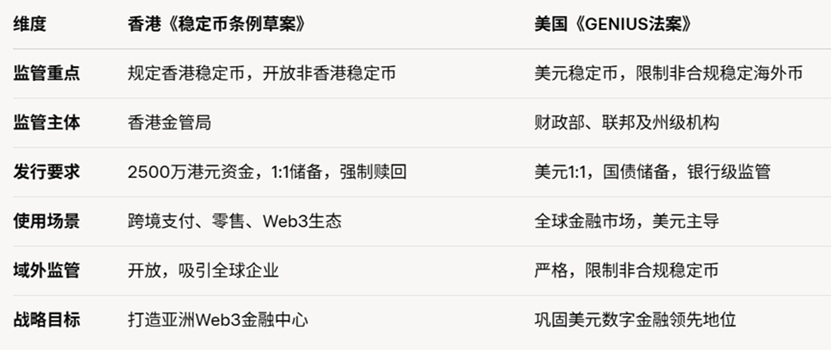From the stablecoin bill, we can see the different strategic visions of China and the United States: the United States views stablecoins as an extension of dollar hegemony in the virtual world, consolidating the global reserve currency status of the dollar by pegging stablecoins to the US dollar, and ensuring stablecoins become a "US-centric" global financial tool.
The increased requirements for stablecoin reserve assets have boosted demand for US Treasury bonds. On May 23rd, US Treasury Secretary Bessen frankly stated in a media interview: "Stablecoins can increase the demand for Treasury bonds and short-term Treasury bills by $2 trillion in the short term, for reference, this number is currently around $300 billion."

While China strictly prohibits cryptocurrencies on the mainland, it uses Hong Kong as a testing ground for stablecoin innovation, actively exploring and laying out stablecoins. The Hong Kong dollar stablecoin serves two purposes: first, to provide infrastructure for Hong Kong's Web3 ecosystem, and second, to bypass the traditional financial system dominated by the West and establish new payment channels.
Alongside stablecoin legislation, the Hong Kong Monetary Authority launched a stablecoin sandbox program in March 2024, with six companies including JD Digits, Yuanbi, and Standard Chartered Bank participating. Currently, these projects are still in the sandbox testing phase, with limited Hong Kong dollar stablecoin transaction volume, and USDT and USDC remain the dominant stablecoins in Hong Kong.
Moreover, stablecoins are just one part of Hong Kong's Web3 ecosystem. On October 31, 2022, the Hong Kong Financial Secretary issued a "Policy Declaration on Virtual Asset Development in Hong Kong," demonstrating the goal and determination to become a global Web3 hub. In recent years, the Hong Kong government has been quietly building.
2023:
Hong Kong issued the world's first tokenized government green bond;
The Hong Kong financial budget allocated 50 million Hong Kong dollars (approximately $6.4 million) to develop the Web3 ecosystem, supporting some enterprises, technology R&D, and community activities.
The Securities and Futures Commission officially implemented the virtual asset trading platform regulatory framework, with platforms like HashKey obtaining licenses, increasing the number of compliant exchanges.
2024:
The Hong Kong Stock Exchange listed 6 Asian virtual asset spot ETFs, including Bitcoin and Ethereum ETFs, ranking first in Asia.
The Securities and Futures Commission approved 7 virtual asset trading platforms (including OSL, HashKey, HKVAX, etc.) and expanded regulation to virtual asset over-the-counter (OTC) trading, custody services, and pledging.
The Monetary Authority launched the "Ensemble" tokenized asset sandbox project, supporting real-world asset (RWA) tokenization experiments and attracting institutions like Ant Group and Standard Chartered Bank.
Promoting blockchain infrastructure construction by collaborating with public chain platforms like Zetrix with Web3Labs and Summer Capital, supporting government and enterprise-level applications.
2025:
The Securities and Futures Commission released the "ASPIRe" roadmap, focusing on market access, protective measures, products, infrastructure, and relationships, aiming to promote Web3 market transparency through information disclosure and simplified securities issuance processes.
Hong Kong hosted the "Consensus Hong Kong 2025" conference, focusing on AI and Web3 integration, discussing emerging fields like decentralized AI networks and AI agent platforms, attracting global Web3 practitioners.
Cyberport Hong Kong attracted over 270 Web3 demand enterprises, involving blockchain games, DeFi, infrastructure, and decentralized science (DeSci).
The Monetary Authority deepened the e-HKD policy, exploring cross-chain payments and cross-border trade applications of central bank digital currencies with Web3.
Although Hong Kong has not yet achieved outstanding results in building a Web3 hub, it has essentially completed its layout with a clear roadmap.
Overall, the United States seeks financial hegemony in the virtual world, while Hong Kong's strategic focus is on the Web3 industry, with the Hong Kong dollar stablecoin still in its infancy. The great power competition has not yet reached its peak.








